In Vedic astrology, the Navagraha—the nine celestial influencers—possess profound significance, representing more than merely celestial bodies; they are dynamic channels of cosmic energy that deeply influence the patterns of human life. Many people often translate Nava-Graha as 9-Planets however the term Graha translates to 'celestial bodies' rather than strictly 'planets.' Each of these Graha represents fundamental aspects of our lives like our physical body, intellect, emotions, opportunities, obstacles, relationships, health, career & spiritual path.
In this article we will explore all about Navagrahas and why do they stand at the heart of Vedic astrology.
Significance & Meaning of Navgraha (9 Planets) in Astrology
-in-Astrology.png)
In the divine principles of Vedic astrology, Navagraha signifies the 'nine celestial influencers,' which include seven apparent planets alongside the two shadow nodes of the Moon, Rahu and Ketu. They function as divine guides, leading us through significant teachings in different aspects of life, from physical well-being to spiritual growth, offering a cosmic map that steers our soul's path.
The nine Grahas rule over special realms of life, having the power to foster balance or create challenges, based on their positioning and association within an individual's astrological chart. Their energies are powerful; they influence our very essence, lead our decisions, and shape our responses to the experiences of life.
For example, Surya embodies our vital self and life force, whereas Chandra reveals our emotional terrain and inner consciousness. Rahu and Ketu, celestial shadows, unveil profound truths, karmic connections, and the crucial teachings that arise from our previous journeys.
Understanding the Navagraha is key for identifying the cosmic forces that intricately shape our existence, guiding us to understand not only the events that unfold, but the deeper reasons behind them. They guide us in recognizing the profound influences that shape our strengths and weaknesses, our dreams and our fears. By attuning ourselves to the profound insights of these celestial bodies, we can cultivate their energies for personal development, face obstacles with maturity, and strive for harmony on our sacred journey.
Let us embark on a profound exploration of the teachings of the Navagraha, revealing the sacred insights that Vedic astrology offers.
Navgraha in Vedic Astrology

In Vedic astrology, each of the Navgraha has specific attributes, energies, and symbolism. They represent cosmic forces that govern different life areas and personality traits. Below is a list of the nine planets in Hindi and English, along with their symbols for easy reference. The Navgraha or 9 Celestial Body Names in Order are:
|
English Name
|
Hindi Name
|
Symbol
|
|
Sun
|
सूर्य
|
☉
|
|
Moon
|
चंद्र
|
☽
|
|
Mars
|
मंगल
|
♂
|
|
Mercury
|
बुध
|
☿
|
|
Jupiter
|
गुरु
|
♃
|
|
Venus
|
शुक्र
|
♀
|
|
Saturn
|
शनि
|
♄
|
|
Rahu
|
राहु
|
☊
|
|
Ketu
|
केतु
|
☋
|
These nine planets are not merely physical entities but symbolic representations of divine energy in Vedic thought. Now that we have a foundational understanding of each Navgraha, let’s look deeper into the specific characteristics and qualities of each.
Characteristics of Each Navgraha in Vedic Astrology

In Vedic astrology, each of the Navagraha embodies distinct energies that influence our lives on physical, mental, emotional, and spiritual levels. Below, we explore each Graha, diving into their traits, strengths, weaknesses, and interactions with other planets.
Sun (Surya)

In Vedic astrology, the Sun signifies one’s fundamental identity, illuminating our true purpose. Known as the King of planets, the Sun represents our soul, vitality, self-expression, and authority. It is the source of energy and governs our inner spirit, ego, and ambitions.
Traits
: Symbol of power, confidence, leadership, and clarity.
Strengths
: Brings courage, vitality, decisiveness, and a sense of purpose.
Weaknesses
: When afflicted in chart, it may lead to arrogance, egotism, or domineering tendencies.
Read More: Sun (Surya Graha) in Astrology
Moon (Chandra)
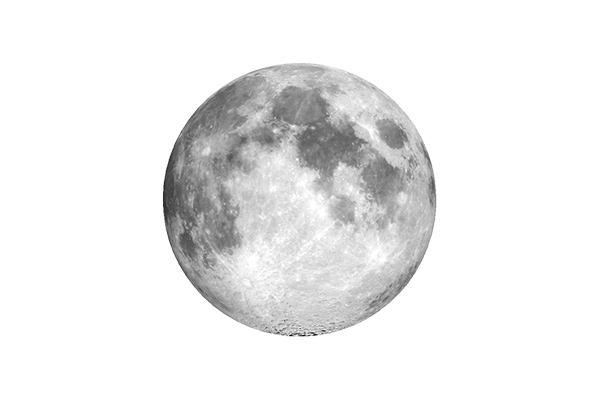
The Moon governs emotions, intuition, and mind. It represents our subconscious, maternal instincts, and how we react emotionally to situations. Representing the feminine and nurturing aspect, it connects us to our feelings, intuition, and inner self. The Moon is deeply tied to maternal energy and our emotional responses to the world.
Traits
: Emotional, intuitive, reflective, and nurturing.
Strengths
: Enhances empathy, adaptability, creativity, and mental peace.
Weaknesses
: Afflictions in the chart may lead to mood swings, insecurity, emotional instability, or indecision.
Read More: Moon (Chandra Graha) in Astrology
Mars (Mangal)
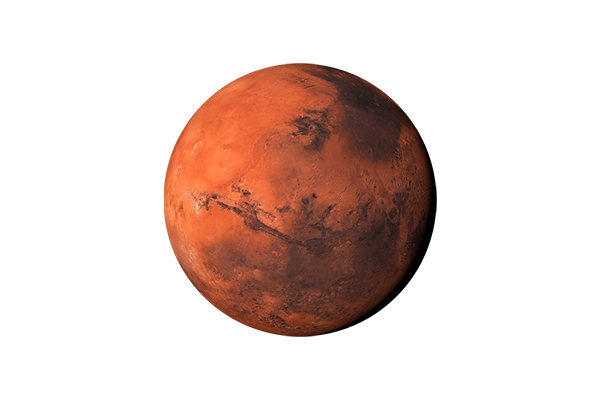
Mars, the warrior planet, symbolizes energy, drive, and assertiveness. It governs courage, physical strength, and the ability to take decisive action, often igniting our competitive spirit and ambition.
Traits
: Bold, dynamic, assertive, and action oriented.
Strengths
: Enhances confidence, bravery, leadership, and resilience.
Weaknesses
: Afflictions in chart, can lead to aggression, impulsivity, anger, or reckless behavior if afflicted.
Read More: Mars (Mangal Graha) in Astrology
Mercury (Budha)
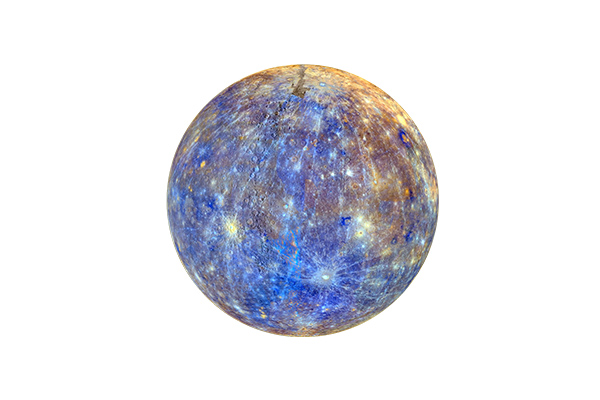
Mercury is linked to intelligence, communication, and adaptability. It represents the analytical mind, governing our capacity for learning, speech, and logical thinking. Known for its volatile nature, Mercury influences how we think, learn, and interact.
Traits
: Intellectual, curious, adaptable, and witty.
Strengths
: Boosts clarity, diplomacy, logic, and communication skills.
Weaknesses
: Afflictions in chart can lead to confusion, miscommunication, anxiety, or indecisiveness.
Read More: Mercury (Budh Graha) in Astrology
Jupiter (Guru)

Jupiter signifies wisdom, growth, and spirituality. It governs growth, philosophy, higher learning, and moral values, providing a guiding light toward purpose and fulfillment often called the “Great Benefic.”
Traits
: Wise, benevolent, optimistic, and expansive.
Strengths
: Encourages generosity, spiritual growth, wisdom, and prosperity.
Weaknesses
: Can lead to overindulgence, dogmatism, or laziness if negatively positioned.
Read More: Jupiter (Guru Graha) in Astrology
Venus (Shukra)

Venus is associated with love, beauty, and pleasure. It governs relationships, art, luxury, and sensual experiences, inspiring creativity and the desire for harmony and connection.
Traits
: Charming, artistic, affectionate, and pleasure-seeking.
Strengths
: Brings harmony, creativity, appreciation for beauty, and refinement in relationships.
Weaknesses
: When afflicted, it can result in vanity, indulgence, possessiveness, or lack of commitment.
Read More: Venus (Shukra Graha) in Astrology
Saturn (Shani)

Saturn is the disciplinarian of the planets, representing responsibility, endurance, and karma. Known for its slow-moving influence, Saturn imparts life lessons through challenges, helping us build resilience and maturity.
Traits
: Disciplined, patient, responsible, and focused.
Strengths
: Strengthens perseverance, maturity, wisdom, and a sense of duty.
Weaknesses
: When malefic, it can lead to hardship, delays, depression, and a sense of restriction.
Read More: Saturn (Shani Graha) in Astrology
Rahu

Rahu, a shadow planet, signifies desires, materialism, and obsessions. Known for creating intense experiences, Rahu’s influence can lead to ambition, unconventionality, and transformative events.
Traits
: Ambitious, unconventional, mysterious, and disruptive.
Strengths
: Boosts innovation, ambition, material success, and exploration of new realms.
Weaknesses
: When uncontrolled, it can cause obsession, confusion, addiction, and instability.
Read More: Rahu (North Node of Moon) in Astrology
Ketu
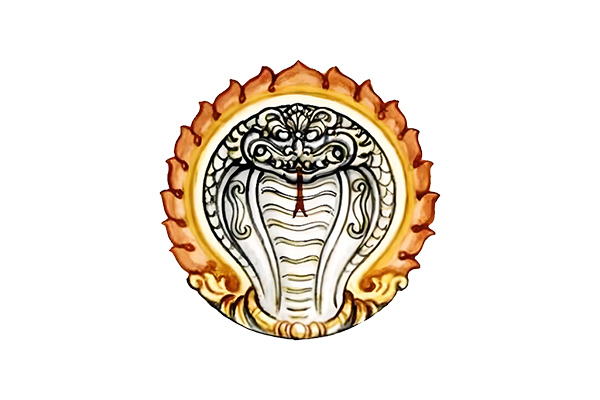
Representing detachment and spirituality, Ketu is the opposite of Rahu, focusing on liberation and past karma. It encourages spiritual growth, often through introspection and surrender, and fosters a sense of enlightenment.
Traits:
Detached, introspective, mystical, and spiritual.
Strengths:
Enhances spiritual insight, intuition, wisdom, and self-realization.
Weaknesses:
When afflicted, it can bring isolation, confusion, or detachment from worldly pursuits.
This overview is just the beginning; each planet holds deeper, transformative lessons and unique influences depending on its placement in different houses.
To truly understand their profound effects on your life’s journey, explore more about the specific teachings and house positions of each Navagraha.
Read More: Ketu (South Node of Moon) in Astrology
How Navagraha Influence Our Horoscope and Life
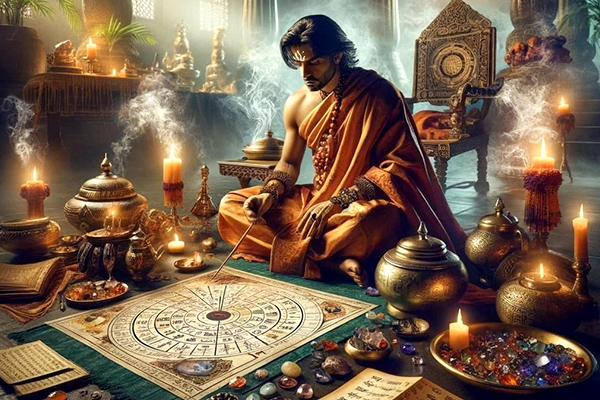
In Vedic astrology, the presence of the Navagraha affects all aspects of our lives, guiding our relationships, health, career, and spiritual well-being. Through the study of each Graha's placement within our birth chart, or Kundali, practitioners of astrology can determine their impact on various aspects of life. In this topic, we will dig into the profound ways in which the Navagraha reveal our journey through various stages of existence.
Each planet’s influence is felt through different means, including:
Placement in Our Kundali & Sub-Divisional Charts

The birth chart (Kundali) is like a cosmic blueprint, capturing the exact positions of the Navagraha at the moment of birth. This chart defines each Graha’s influence on various aspects of life. Each Graha rules over specific houses (or Bhavas), governing areas like family, career, wealth, and health.
For instance, Jupiter, the planet of wisdom and expansion, brings good fortune and growth when positioned well. Saturn, however, may introduce discipline or hardships, especially when occupying challenging houses.
Sub-divisional charts, or Vargas, further refine these interpretations. By examining a planet’s placement across these divisional charts, we gain deeper insights into specific aspects, such as marriage (Navamsa), wealth (Dhanamsa), and career (Dasamsa). Understanding planetary placement across these layers reveals not only overarching themes but also subtle nuances affecting each part of life.
Dashas (Planetary Periods)
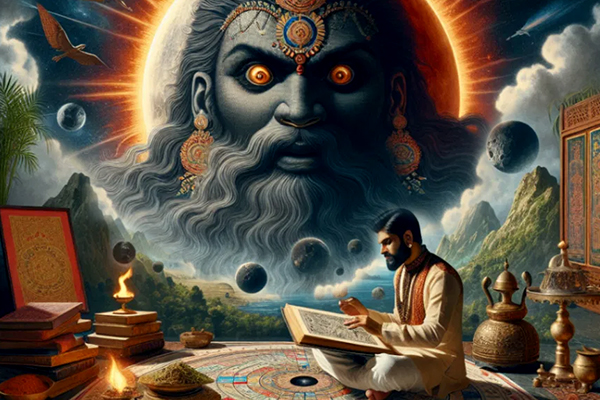
Dashas, or planetary periods, are specific phases in our lives when the influence of one Graha dominates, shaping experiences, relationships, and personal growth. Each Dasha lasts for a certain period, varying from a few years to several decades, depending on the Graha. During a Dasha, the ruling Graha’s energy becomes more intense, either bringing favorable outcomes or presenting challenges.
For example, a Jupiter Dasha often brings expansion, wisdom, and prosperity, making it a period of growth and fulfillment. In contrast, a Saturn Dasha may demand patience and discipline, potentially presenting obstacles to test one’s endurance. By understanding these cycles, we can better prepare for what lies ahead, working with each planetary period’s energy rather than resisting it. Below is the chart of Planetary Dasha.
|
Planetary Dasha
|
Dasha Duration (Years)
|
|
Sun
|
6
|
|
Moon
|
10
|
|
Mars
|
7
|
|
Rahu
|
18
|
|
Jupiter
|
16
|
|
Saturn
|
19
|
|
Mercury
|
17
|
|
Ketu
|
7
|
|
Venus
|
20
|
Transits

While the birth chart is a snapshot of the planets at our time of birth, the planets are always moving across the sky. These movements, or transits, impact our current circumstances, moods, and life events. Some transits can be highly favorable, opening doors for opportunity and growth, while others may bring cautionary lessons or temporary setbacks.
For instance, the transit of Jupiter over key points in a chart often signals a time of blessings, prosperity, and opportunity. Conversely, Saturn’s transits can bring limitations or responsibilities that require hard work. Notably, the Sade Sati—the seven-and-a-half-year period when Saturn transits around the Moon—tests patience, maturity, and resilience. Understanding transits helps us respond to life’s shifts more mindfully, knowing when to act and when to exercise caution.
|
Planet
|
Transit Duration
|
|
Sun
|
30 days (1 month)
|
|
Moon
|
2.25 days
|
|
Mars
|
45 days (1.5 months)
|
|
Mercury
|
21 days (3 weeks)
|
|
Jupiter
|
12.5 months (1 year 5 months)
|
|
Venus
|
26 days (a little under 1 month)
|
|
Saturn
|
2.5 years (30 months)
|
|
Rahu and Ketu
|
19 months (1 year 7 months)
|
Aspects of Planets in Vedic Astrology
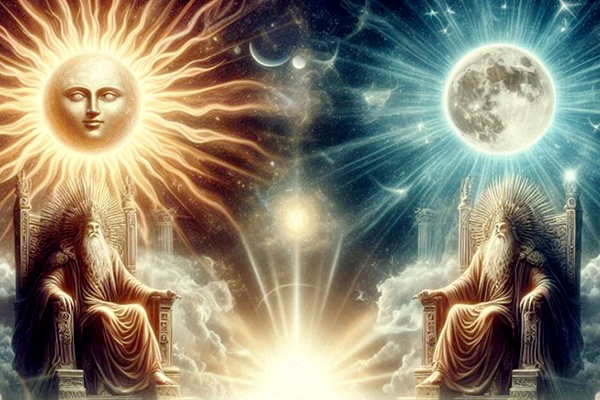
Aspects (Drishti) in Vedic astrology refer to the angular influences that planets exert on each other and specific houses in a horoscope. These aspects determine how planets interact, either harmonizing energies or creating tension, and shape the dynamics of an individual’s life. Unlike Western astrology, Vedic astrology defines specific numbered aspects for each planet, each with a distinct intensity and significance.
|
Planet
|
Aspects (Degrees)
|
Intensity
|
Significance
|
|
Sun
|
7th house (180°)
|
100%
|
Influences partnerships, relationships, and public dealings.
|
|
Moon
|
7th house (180°)
|
100%
|
Impacts emotional connections, relationships, and adaptability.
|
|
Mercury
|
7th house (180°)
|
100%
|
Focuses on communication, intellect, and relationship balance.
|
|
Venus
|
7th house (180°)
|
100%
|
Enhances love, harmony, and beauty in relationships.
|
|
Mars
|
4th house (90°), 7th house (180°), 8th house (210°)
|
75%, 100%, 50%
|
Affects emotional stability (4th), partnerships (7th), and transformation (8th).
|
|
Jupiter
|
5th house (120°), 7th house (180°), 9th house (240°)
|
75%, 100%, 75%
|
Promotes creativity (5th), partnership harmony (7th), and spiritual growth (9th).
|
|
Saturn
|
3rd house (60°), 7th house (180°), 10th house (270°)
|
50%, 100%, 75%
|
Shapes courage (3rd), partnerships (7th), and career responsibilities (10th).
|
|
Rahu
|
5th house (120°), 7th house (180°), 9th house (240°)
|
75%, 100%, 75%
|
Amplifies ambition (5th), relationship intensity (7th), and unconventional spirituality (9th).
|
|
Ketu
|
5th house (120°), 7th house (180°), 9th house (240°)
|
75%, 100%, 75%
|
Encourages detachment in creativity (5th), spiritual lessons in partnerships (7th), and introspection in spiritual growth (9th).
|
Note: In Vedic astrology, a complete zodiac circle is 360°, divided into 12 houses, each spanning 30°. Aspect degrees are calculated based on the angular distance a planet influences specific houses within this 360° framework.
Planetary Friendships

In Vedic astrology, understanding the nature of your Lagna (Ascendant) and Lagna Lord—the ruling planet of your ascendant sign—is crucial. The ascendant sets the stage for the entire birth chart, influencing your personality, life path, and how each planet interacts with you. The Lagna Lord’s relationship with other planets reveals which planets act as natural allies (benefic) or challengers (malefic) to your life’s goals and inner harmony. Below is a guide on each planet’s role based on different Lagnas and how understanding these relationships can help you navigate life’s patterns.
|
Ascendant
|
Benefic Planets | Malefic Planets |
|
Aries
|
Sun, Moon, Jupiter, Mars | Mercury, Venus, Saturn |
|
Taurus
|
Saturn, Mercury, Moon | Sun, Moon, Jupiter |
|
Gemini
|
Venus, Saturn, Mercury | Mars, Jupiter, Sun |
|
Cancer
|
Mars, Jupiter, Moon | Saturn, Venus, Mercury |
|
Leo
|
Mars, Jupiter, Sun | Venus, Saturn, Mercury |
|
Virgo
|
Venus, Mercury | Mars, Moon, Sun |
|
Libra
|
Saturn, Mercury | Sun, Mars, Jupiter |
|
Scorpio
|
Jupiter, Moon, Mars | Venus, Saturn, Mercury |
|
Sagittarius
|
Mars, Jupiter, Sun | Venus, Saturn, Mercury |
|
Capricorn
|
Venus, Mercury, Saturn | Sun, Moon, Mars |
|
Aquarius
|
Venus, Mercury, Saturn | Sun, Moon, Mars |
|
Pisces
|
Mars, Moon, Jupiter | Venus, Saturn, Mercury |
Natural Malefic and Benefic Planets in Vedic Astrology

In Vedic astrology, planets are broadly classified as naturally benefic or naturally malefic, based on the general type of energy they impart. Benefic planets are often linked to harmony, growth, and positivity, while malefic planets are associated with challenges, discipline, and transformative experiences.
However, it is crucial to understand that planets are neither inherently friends nor enemies; each serves a purpose in shaping your life journey.
Benefic Planets: These planets support your growth and well-being, nurturing you with positivity, protection, and abundance.
Malefic Planets: These planets challenge you, creating obstacles and difficulties that, when faced with determination, help you grow stronger, wiser, and more resilient.
This classification is not absolute. The same planet may act as a benefic or malefic depending on the individual’s ascendant (Lagna), chart placements, and planetary relationships.
Natural Benefic Planets
Jupiter (Guru)
-a.png)
Jupiter represents the embodiment of morality, symbolizing growth, fundamental understanding, and kindness. Revered as the “Great Benefic,” Jupiter bestows upon us the gifts of growth, generosity, and optimism. When positioned with intention, it opens pathways for awakening, abundance, and significant growth. The influence of Jupiter serves as a guiding light, providing stability and balance, and alleviating severe impacts of harder planets. In specific placements, particularly within the 6th or 8th house, the expansive essence may manifest in ways that can become overwhelming, possibly resulting in overindulgence or a lack of motivation.
Venus (Shukra)
-a.png)
Venus embodies the essence of beauty, love, and harmony, serving as a divine benefactor that enriches our experiences, fosters creativity, and nurtures the fulfilment of relationships. It embodies the essence of joy, splendor, and creative manifestation, frequently bestowing comfort and social sophistication. The benevolent presence of Venus has the power to transform life's trials into manageable experiences, integrating them with a sense of elegance and an intimate connection to the beauty that surrounds us. Yet, it is important to recognize that Venus may adopt a challenging nature in specific houses or aspects, which can result in ego, attachment, or an overindulgence in material pursuits.
Mercury (Budha)
-a.png)
Mercury is the planet of intellect and communication, and is revered for its benevolent nature, related to its remarkable adaptability and major intellectual qualities. It governs the realms of knowledge, inquiry, and intellectual clarity, promoting wisdom and the ability to navigate challenges with insight. Mercury displays a distinctive quality, reflecting the essence of the celestial bodies it interacts with, occasionally exhibiting adverse characteristics when under the influence of challenging planets such as Saturn or Mars. However, its basic nature is largely positive, nurturing the flow of communication and the ability to adapt in the diverse situations that life presents.
Moon (Chandra) - Shukla Paksha (Waxing Phase)
The Moon, in its waxing phase, is considered as a source of positive influence and blessings. During this phase, the Moon reveals its nurturing and instinctive essence, encouraging an intense feeling of balance and emotional stability within us. It stimulates a profound sense of compassion, empathy, and intuition, guiding individuals to develop a deeper connection with their inner self. However, the Moon's presence holds enormous significance, particularly in relation to its positioning and aspects. During the waning phase, one must be vigilant, for its energy may transition into a more challenging influence.
Natural Malefic Planets
Saturn (Shani)
-a.png)
Saturn is considered as a natural malefic planet, reflecting the principles of discipline, limitation, and the deeper teachings of karma. It often brings trials, obstacles, and moments of reflection, compelling us to confront the truth and cultivate strength of spirit. While the influence of Saturn may be challenging, it serves a higher purpose, guiding us towards the ideals of responsibility, patience, and maturity. In specific chart placements, Saturn could represent a favorable influence, particularly when it is strong and well-aspected, as it can provide stability and unwavering determination in the pursuit of maintaining aspirations.
Mars (Mangal)
-a.png)
Mars, the warrior planet, is another natural malefic. Its intense energy drives action, competition, and ambition, often creating conflict or impulsive tendencies. While Mars provides strength and courage, its influence can turn aggressive or destructive if not tempered. When positioned favorably, Mars can act as a source of motivation and assertiveness, helping to overcome obstacles. However, in challenging houses or aspects, its malefic nature can lead to disputes, anger, and impulsiveness.
Rahu
Rahu, one of the two shadow planets, is known for its malefic qualities associated with material desires, obsessions, and illusions. It often leads us into unconventional or risky pursuits, bringing unfulfilled desires to the forefront. Rahu’s influence can be destabilizing, creating periods of confusion or temptation toward excessive ambition. However, when placed favorably, Rahu can provide unexpected growth, helping us break free from traditional constraints and explore new territories.
Ketu
Ketu, the counterpart to Rahu, is also considered malefic but operates differently. While Rahu seeks material fulfillment, Ketu represents detachment, spirituality, and the dissolution of ego. It often brings challenges that push us toward inner transformation and renunciation. Ketu’s influence can feel isolating or unsettling, as it challenges attachment to worldly matters. When positively placed, Ketu can provide profound spiritual insight and a deep sense of purpose.
Moon (Chandra) - Krishna Paksha (Waning Phase)
During the waning phase (Krishna Paksha), the Moon takes on a more malefic role, as its energy begins to withdraw and contract. In this phase, the Moon may introduce moodiness, emotional instability, or excessive introspection. Its impact becomes more passive and can create fluctuations in mental peace. However, in certain chart placements and ascendants, even the waning Moon can support spiritual introspection and self-reflection.
The Neutral Planet: Sun
Sun (Surya)
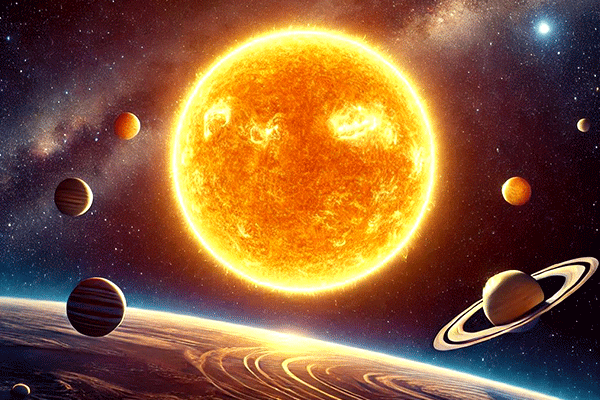
The Sun is often classified as a neutral planet because it doesn’t inherently lean toward being either benefic or malefic. Instead, its influence is context-dependent, taking on characteristics based on its placement, house position, and aspects. The Sun represents the self, ego, and vitality, symbolizing our core identity and life purpose. When placed well, it can bring clarity, strength, and leadership qualities, acting benefic in nature. In challenging houses or aspects, however, the Sun may become too forceful, potentially leading to ego conflicts, arrogance, or issues with authority.
Shifting Roles of Benefic and Malefic Planets

It’s important to note that the classifications of benefic and malefic are not fixed. The nature of each planet can change based on the ascendant in an individual’s Kundali. For example, while Jupiter is naturally benefic, it may become malefic for certain ascendants, such as Taurus, where it governs the challenging 8th and 11th houses. Similarly, malefic planets like Mars or Saturn can take on a benefic role if they rule favorable houses in a specific ascendant chart.
Understanding a planet’s tendency to be benefic or malefic according to one’s individual chart provides greater insight into life patterns, challenges, and strengths. By analyzing these inclinations, astrologers can guide individuals toward remedies and strategies that harness supportive planetary energies while mitigating or balancing challenging influences.
For those seeking deeper understanding, exploring how each Graha’s nature shifts across different ascendants can reveal profound insights into unique karmic influences and personal growth pathways within the broader journey of life.
|
Ascendant
|
Benefic Planets | Malefic Planets |
|
Aries
|
Sun, Moon, Jupiter, Mars | Mercury, Venus, Saturn |
|
Taurus
|
Saturn, Mercury, Moon | Sun, Moon, Jupiter |
|
Gemini
|
Venus, Saturn, Mercury | Mars, Jupiter, Sun |
|
Cancer
|
Mars, Jupiter, Moon | Saturn, Venus, Mercury |
|
Leo
|
Mars, Jupiter, Sun | Venus, Saturn, Mercury |
|
Virgo
|
Venus, Mercury | Mars, Moon, Sun |
|
Libra
|
Saturn, Mercury | Sun, Mars, Jupiter |
|
Scorpio
|
Jupiter, Moon, Mars | Venus, Saturn, Mercury |
|
Sagittarius
|
Mars, Jupiter, Sun | Venus, Saturn, Mercury |
|
Capricorn
|
Venus, Mercury, Saturn | Sun, Moon, Mars |
|
Aquarius
|
Venus, Mercury, Saturn | Sun, Moon, Mars |
|
Pisces
|
Mars, Moon, Jupiter | Venus, Saturn, Mercury |
Why Understanding Benefic and Malefic Relationships Matters
These relationships influence key areas of life, including health, career, and relationships. Benefic planets often provide protection, growth, and ease, making it easier to access opportunities in the areas they govern. Malefic planets, on the other hand, can introduce challenges that may feel like obstacles but are often important lessons in resilience and personal growth.
Graha Karakas (Planetary Significators)
In Vedic astrology, Natural Karakas represent universal significations that are fixed for all charts, while Chara Karakas (variable significators) are determined based on the planetary degrees in an individual’s chart. Here are the details with defined degrees:
Natural Karakas (Navgraha Karakatvas)
The Natural Karakas have as firm symbols across all charts, representing universal life themes that go beyond the individuality of each birth chart. Every celestial body holds a unique purpose, guiding the many aspects of our lives and illuminating our journey of personal development, connections, and destiny. Let us explore the inherent meanings attributed to each celestial body:
|
Planet
|
Natural Karaka For
|
|
Sun
|
Soul (
Atma
), father, authority figures
|
|
Moon
|
Mind (
Manas
), emotions, mother
|
|
Mars
|
Siblings, courage, property, physical strength
|
|
Mercury
|
Intelligence, communication, friends
|
|
Jupiter
|
Wisdom, children, spirituality
|
|
Venus
|
Love, marriage, creativity, luxuries
|
|
Saturn
|
Discipline, longevity, service, karma
|
|
Rahu
|
Ambitions, foreign influences, material desires
|
|
Ketu
|
Detachment, spirituality, past karma
|
Each of these planets holds a unique place in Vedic astrology, shaping specific dimensions of our lives. Understanding the role of these Natural Karakas provides insights into fundamental aspects of human experience, guiding us toward deeper self-awareness and spiritual growth.
Chara Karakas (Unique Planetary Significators in Vedic Astrology)
In the field of Vedic astrology, Chara Karakas act as distinctive planetary significators, intricately suited to everyone individually, influenced by the degrees of the celestial bodies within one's birth chart. In contrast to the unchanging and universal Natural Karakas, Chara Karakas convey the distinct relationships and roles that are uniquely woven into the fabric of every person's existence. Through the study of Chara Karakas, one may uncover deep understanding regarding the unfolding of specific relationships and life roles.
Here’s a breakdown of each Chara Karaka and its significance:
Chara Karakas (Variable Significators by Degrees)
.jpg)
The Chara Karakas are determined based on the degrees of planets in the birth chart. The planet with the highest degree becomes the Atma Karaka (Soul Significator), followed by others to signify specific roles in life. Here’s how the Chara Karakas are assigned:
|
Chara Karaka
|
Role
|
Planetary Degree Rule
|
|
Atma Karaka
|
Soul significator
|
Planet with the highest degree
|
|
Amatya Karaka
|
Career, guidance
|
Second highest degree
|
|
Bhratru Karaka
|
Siblings, courage
|
Third highest degree
|
|
Matru Karaka
|
Mother, nourishment
|
Fourth highest degree
|
|
Pitru Karaka
|
Father, authority
|
Fifth highest degree
|
|
Putra Karaka
|
Children, creativity
|
Sixth highest degree
|
|
Gnati Karaka
|
Health, enemies, obstacles
|
Seventh highest degree
|
|
Dara Karaka
|
Spouse, relationships
|
Planet with the lowest degree
|
Degrees Clarification for Chara Karakas
Atma Karaka: Planet with the highest degree among all planets (except Rahu and Ketu). It signifies the soul’s journey and purpose in life.
Dara Karaka: Planet with the lowest degree, representing marriage and partnerships.
If two planets have the same degree, the Chara Karaka is assigned based on their minutes and seconds of arc.
Note: Specific Numerical Degrees: No predefined numerical values are used (e.g., 'Atma Karaka must be above 25°'); the roles depend purely on degree ranking in the chart.
Minutes and Seconds: If two planets have the same degree, their exact minutes and seconds are compared. The one with the higher minutes/seconds is considered the higher Chara Karaka.
Each Chara Karaka reflects a unique area of life, illustrating how relationships and roles influence personal growth and fulfillment. By understanding one’s Chara Karakas, we can gain deeper clarity into life’s dynamics and develop more conscious connections with family, career, and self. This insight becomes especially valuable when examining planetary aspects and interactions in the chart, revealing not only challenges but also potential for growth in each life area.
Bhava Karakas (House Significators)
.jpg)
In Vedic astrology, Bhava Karakas are the natural significators (Karakas) of each house (Bhava), representing the key themes and influences related to the specific areas of life governed by that house. These are fixed and universal for all charts, meaning they remain constant regardless of the individual’s planetary placements or ascendant.
Here’s how the Bhava Karakas are assigned:
|
House
|
Bhava Karaka
|
Key Themes
|
|
1st House (Ascendant)
|
Sun
|
Represents vitality, self-expression, health, and personality.
|
|
2nd House
|
Jupiter, Mercury, Venus
|
Governs wealth, speech, family values, and material stability.
|
|
3rd House
|
Mars
|
Reflects courage, siblings, communication, and short travels.
|
|
4th House
|
Moon
|
Represents mother, emotions, home, and comfort.
|
|
5th House
|
Jupiter
|
Governs intelligence, creativity, children, and education.
|
|
6th House
|
Mars, Saturn
|
Influences health, enemies, debts, and daily responsibilities.
|
|
7th House
|
Venus
|
Represents partnerships, marriage, and public dealings.
|
|
8th House
|
Saturn
|
Governs longevity, transformation, secrets, and the occult.
|
|
9th House
|
Jupiter, Sun
|
Influences luck, spirituality, higher education, and long journeys.
|
|
10th House
|
Mercury, Saturn, Sun
|
Represents career, authority, reputation, and achievements.
|
|
11th House
|
Jupiter, Mercury
|
Governs gains, aspirations, social connections, and income.
|
|
12th House
|
Saturn, Ketu
|
Represents spirituality, expenses, isolation, and liberation (Moksha).
|
Remedies to Balance the Effects of Navagraha (9 Celestial Bodies)
Balancing the effects of the Navagraha (9 celestial bodies) is vital for harmonizing planetary energies. Remedies include karmic alignment, wearing specific Rudrakshas, using gemstones, and practicing mantra chanting and yantras. These tools help mitigate challenges, attract positivity, and bring balance to life.
Karmic Alignment
In Vedic astrology, the actions we take hold immense significance in coordinating the effects of planetary positions. Performing good deeds with genuine intentions can reduce or balance the challenging influences of planets. By aligning one’s actions with the karmic essence of each celestial body, we can harmonize their energies and promote personal growth.
For example, Saturn (Shani), the planet of discipline, karma, and perseverance, often presents challenges in the form of delays, hardships, or increased responsibilities. To balance Saturn’s effects, it is essential to embrace discipline, patience, and accountability in daily life. Practices such as helping the underprivileged, taking on responsibilities with humility, and dedicating oneself to hard work foster harmony with Saturn's energy. These actions not only mitigate its malefic effects but also encourage growth, resilience, and inner strength.
Aligning one's actions with the karmic lessons of each planet allows for smoother navigation of life’s obstacles and promotes a deeper sense of spiritual alignment and balance.
Rudraksha for Each Navagraha

Click on the link to buy Rudraksha as per your planet
Rudraksha beads, sacred to Vedic tradition, are believed to possess powerful energies that correspond with the Navagraha. Wearing specific Rudraksha beads aligned with each planet can provide protection, enhance benefic effects, and neutralize challenging influences. Here’s a guide to Rudraksha for each Graha:
|
Planet
|
Rudraksha Bead
|
|
Sun
|
12 Mukhi Rudraksha
|
|
Moon
|
2 Mukhi Rudraksha
|
|
Mars
|
6 Mukhi Rudraksha
|
|
Mercury
|
15 Mukhi Rudraksha
|
|
Jupiter
|
4 Mukhi Rudraksha
|
|
Venus
|
7 Mukhi Rudraksha
|
|
Saturn
|
17 Mukhi Rudraksha
|
|
Rahu
|
9 Mukhi Rudraksha
|
|
Ketu
|
8 Mukhi Rudraksha
|
Rudra Centre, a pioneer in selling authentic Rudrakshas online, is your one-stop destination for all types of Rudraksha beads, ensuring quality, authenticity, and expert guidance.
Gemstones for Each Navagraha

Click on the link to buy suitable Gemstones
Gemstones have long been used in Vedic astrology to strengthen and balance planetary energies. Each Navagraha has an associated gemstone that, when worn, can harmonize its influence. Here is a guide to gemstones aligned with each planet:
|
Planet
|
Gemstones
|
|
Sun
|
Ruby
|
|
Moon
|
Pearl
|
|
Mars
|
Red Coral
|
|
Mercury
|
Emerald
|
|
Jupiter
|
Yellow Sapphire
|
|
Venus
|
Diamond
|
|
Saturn
|
Blue Sapphire
|
|
Rahu
|
Hessonite Garnet Gomed
|
|
Ketu
|
Cat’s Eye
|
These gemstones, when chosen carefully based on the birth chart, can support planetary alignment, bring balance, and enhance auspicious outcomes in areas of life governed by each planet.
Pujas
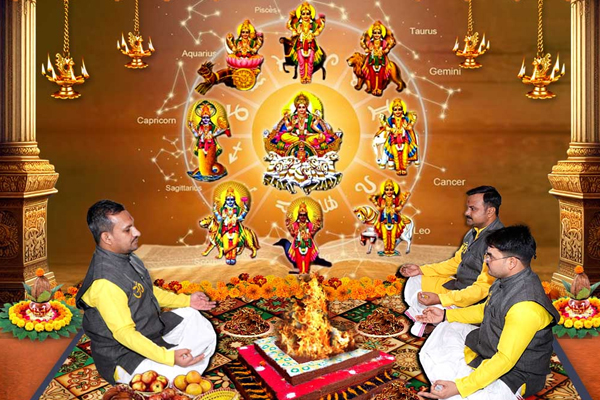
Special Pujas are powerful remedies to appease specific planets, helping to reduce malefic effects and attract positive vibrations. One such profound ritual is the Navagraha Puja, which is performed to mitigate or eliminate the negative influences caused by the inauspicious placement of planets in the birth chart.
Rudra Centre, one of the most trusted and oldest Puja service providers globally, offers authentic Navagraha Puja services conducted by a team of over 250+ highly skilled Karmakandi Pandits from Kashi (Varanasi). These experienced Vedic priests ensure that every ritual is performed with precision and adherence to ancient Vedic traditions, bringing maximum benefits to the devotees.
Yantras:
Yantras are sacred geometrical representations of divine energies, serving as powerful tools for aligning with cosmic forces to achieve spiritual growth and material success. They help attract harmony, positivity, and balance in life.
Donations
Offering specific donations (daan) aligned with each planet helps alleviate malefic effects and attract positive energies. Rudra Centre provides expert guidance on planet-specific donations to promote balance and harmony in life. Here is a table of suggested donations for each Navagraha and the benefits they provide:
|
Planet
|
Donation Items
|
|
Sun
|
Wheat, copper, red cloth
|
|
Moon
|
Rice, silver, white cloth, milk
|
|
Mars
|
Red lentils, red flowers, jaggery
|
|
Mercury
|
Green gram (moong dal), green cloth, books
|
|
Jupiter
|
Yellow gram (chana dal), turmeric, yellow cloth
|
|
Venus
|
White sweets, yogurt, fragrant items
|
|
Saturn
|
Black sesame seeds, black cloth, iron
|
|
Rahu
|
Black lentils (urad dal), coconut, blue or black cloth
|
|
Ketu
|
Blanket, brown items, mustard seeds
|
To donate as per your astrologer’s recommendation, click on the link to donate .
Mantra Japa for Navagraha (Beej Mantras and Vedic Mantras)
In Vedic astrology, chanting specific Beej Mantras (seed sounds) and Vedic Mantras for each planet can harmonize one's energy with the cosmic forces of the Navagraha. These mantras serve as powerful tools to alleviate challenges, enhance positive qualities, and align with each planet's spiritual essence. Regular chanting of these mantras creates a vibrational resonance that mitigates malefic effects and brings balance and prosperity.
Here is a detailed list of each planet’s Beej Mantra and Vedic Mantra, along with number of Japas to do and the auspicious day:
|
Planet
|
No. of Japa
|
Auspicious Day
|
Beej Mantra
|
Vedic Mantra
|
|
Sun (Surya)
|
7000
|
Sunday
|
Om Hraam Hreem Hraum Sah Suryaya Namah
|
Om Ghrinih Suryaya Namah
|
|
Moon (Chandra)
|
11000
|
Monday
|
Om Shraam Shreem Shraum Sah Chandramase Namah
|
Om Chandraya Namah
|
|
Mars (Mangal)
|
10000
|
Tuesday
|
Om Kraam Kreem Kraum Sah Bhaumaya Namah
|
Om Angarakaya Namah
|
|
Mercury (Budha)
|
9000
|
Wednesday
|
Om Braam Breem Braum Sah Budhaya Namah
|
Om Budhaya Namah
|
|
Jupiter (Guru)
|
19000
|
Thursday
|
Om Graam Greem Graum Sah Gurave Namah
|
Om Brihaspataye Namah
|
|
Venus (Shukra)
|
16000
|
Friday
|
Om Draam Dreem Draum Sah Shukraya Namah
|
Om Shukraya Namah
|
|
Saturn (Shani)
|
23000
|
Saturday
|
Om Praam Preem Praum Sah Shanaishcharaya Namah
|
Om Shanaischaraya Namah
|
|
Rahu
|
18000
|
Saturday
|
Om Bhraam Bhreem Bhraum Sah Rahave Namah
|
Om Rahave Namah
|
|
Ketu
|
17000
|
Tuesday
|
Om Sraam Sreem Sraum Sah Ketave Namah
|
Om Ketave Namah
|
Conclusion
The Navagraha are much more than celestial bodies; they are potent cosmic energies that shape and guide our life journey. By understanding their unique qualities and learning how to balance their influences, we gain deeper wisdom, greater awareness, and the tools to navigate life’s challenges with resilience. Exploring the Navagraha enriches our personal growth, supports spiritual alignment, and fosters harmony within ourselves and our environment.


-in-Astrology.jpg)






.jpg)
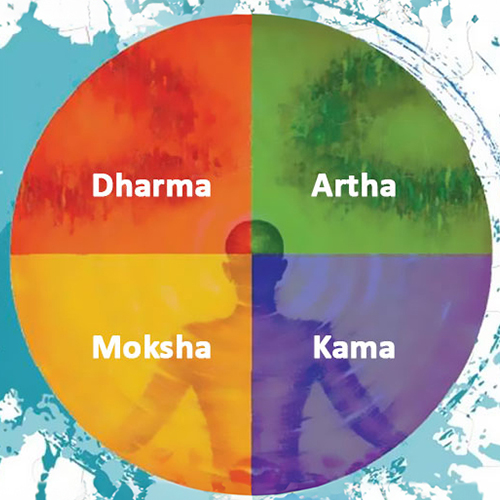


Comments 0
Leave your thought here